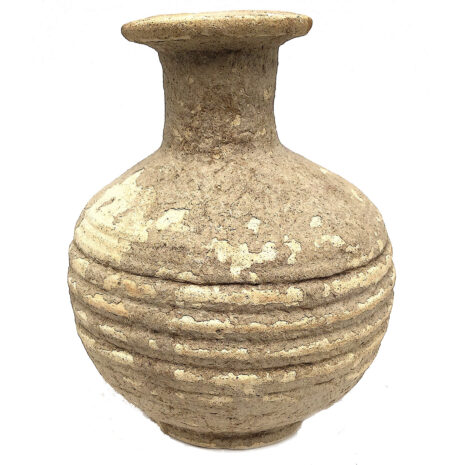Ancient Earthenware Jarlet, Roman North Africa H: 4.6″
Original price was: $225.00.$125.00Current price is: $125.00.
Ht: 4.625″ Dia: 3.625” | FREE SHIPPING WITHIN CONTINENTAL U.S.!
Most small utilitarian pottery jars like this were made in ceramics centers in Africa-Proconsularis, the Roman North Africa territories and were either a perfume, oil, ointment or cosmetic jars. Wheel made it is simple with grooved furrows etched on the surface.
Description
This small earthenware jarlet was made using a potter’s wheel, fired in a kiln and is one of many pouring vessels used throughout the Roman Empire. It was made in a ceramics center in Africa-Proconsularis, the Roman North Africa territories. Made from clay, it is covered with a beige or white slip. These daily-use objects were made for ordinary people and their decorations, if any, were confined to simple linear patterns or grooved furrows etched on the surface while the object turned on the wheel such as the ribbing here. This one likely fell in the kiln, as one side is flat and lost some ribbing making its stance slightly askew. This uncleaned vessel survived intact, has no repairs and is otherwise in very good condition with aged patina, expected mineral deposits and incrustation on the surface, losses and hairline cracks, minor chips and some discoloration to the slip due to its use and age. It stands on a low foot and remains a good example of a ceramic item from ancient history and the Roman Empire.
Additional information
| Weight | 4 lbs |
|---|---|
| Dimensions | 6 × 6 × 6 in |
| Period | Ancient, Roman Empire |
| Date | 1st-3rd Century C.E. |
| Materials and Technique | Terracotta |
| Dimensions (inches) | Ht: 4.625" Dia: 3.625” |
| Dimensions (metric) | Ht: 11.7475cm Dia: 9.2075cm |
| Weight | 7.2 oz |
| Condition | Very good, see description |
| Item Number | 3195A-DAE |
| Shipping Box Size |








